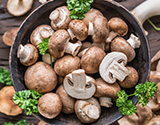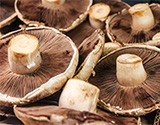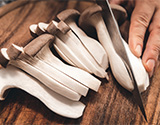Mushroom Category Guide
Page contents:
Popular Mushroom Varieties | Mushroom Grades | Growth Process | Storage and Handling
Popular Mushroom Varieties
| Variety | Primary Applications and Attributes |
|---|---|
| White (Button) |
|
| Brown Cremini (Baby Portabella) |
|
| Brown Portabella |
|
| Exotic Variety | |
| Shiitake |
|
| Hon Shimeki (Beech) |
|
| Oyster |
|
Check with your Seller for additional varieties in your market.
MUSHROOM grades
U.S. No. 1
Consists of fresh mushrooms of similar varietal characteristics, which are mature, fairly well-shaped, well-trimmed, free from open veils, disease, spots, insect injury, decay or from damage by any cause. Size is specified in terms of diameter and, unless otherwise specified, meets the requirements of one of the following size classifications:
- Small to medium: Up to 1-5/8 inches in diameter.
- Large: Over 1-5/8 inches in diameter.
U.S. No. 2
The requirements for this grade are the same as for U.S. No. 1, except for a greater tolerance for open veils and a larger tolerance for defects.
Source: U.S. Department of Agriculture
GROWTH PROCESS
Typically grown on a year-round cycle, mushrooms have one of the most interesting farm-to-fork agricultural stories, because mushrooms are technically considered fungi. Unlike plants, mushrooms lack chlorophyll to make their own food through photosynthesis, and instead exist on a substrate of organic material.
MUSHROOM STORAGE AND HANDLING TIPS
Follow these storage and handling tips to help maintain mushroom quality and shelf life.
- Immediately refrigerate both bulk and prepackaged mushrooms at 34° F (Blue Zone), closest to the cooler fan
- Keep in the original package and refrigerate
- Do not store in plastic bags or near pungent items
- Do not stack heavy items on top of mushroom containers, to prevent damage
- Typical shelf life from the time of harvest when kept under proper storage conditions:
- Most varieties: 5–8 days
- Shiitake: 8 days
- Oyster: 8 days
- Portabella: 8 days
- Fresh-cut: 5–8 days
- Wash mushrooms just prior to serving, under cold, running water. Only prepare what you will use in a day to avoid spoilage
- Use a soft brush to remove any traces of peat moss or soil, or rinse quickly and pat dry to clean
- Avoid soaking fresh mushrooms, or rinsing open veiled mushrooms as it may add excess moisture


 Known for their smooth, rounded caps with short, truncated stems that vary in color from creamy white to light brown. Mild in flavor when raw and more intense, fragrant and meaty when cooked. Great for sautéeing, roasting, grilling or broiling.
Known for their smooth, rounded caps with short, truncated stems that vary in color from creamy white to light brown. Mild in flavor when raw and more intense, fragrant and meaty when cooked. Great for sautéeing, roasting, grilling or broiling. Similar to white mushrooms, with a light to dark brown cap, a short white stem and small brown gills hidden beneath the cap. A mild, more earthy flavor than white mushrooms, with a meaty texture ideal for soups, stews, salads, sauces and side dishes. Highly versatile, they can be cooked almost any way.
Similar to white mushrooms, with a light to dark brown cap, a short white stem and small brown gills hidden beneath the cap. A mild, more earthy flavor than white mushrooms, with a meaty texture ideal for soups, stews, salads, sauces and side dishes. Highly versatile, they can be cooked almost any way. A Portabella is a more mature Cremini, which is the main difference between the two. They have light to dark brown caps with a short white stem and small brown gills hidden beneath the cap. These mushrooms are known for their deep, dense flavor and meaty texture, which makes them ideal for Portabella burgers topped with lots of cheese.
A Portabella is a more mature Cremini, which is the main difference between the two. They have light to dark brown caps with a short white stem and small brown gills hidden beneath the cap. These mushrooms are known for their deep, dense flavor and meaty texture, which makes them ideal for Portabella burgers topped with lots of cheese. Varying from tan to dark brown, with broad umbrella-shaped caps, they have wide open veils and tan gills that have a rich and woodsy flavor when cooked. Commonly sautéed and used in stir fries, pastas, soups, entrées and sides. Stems are tough and should be cut off prior to cooking, but can be used to add flavor to stock.
Varying from tan to dark brown, with broad umbrella-shaped caps, they have wide open veils and tan gills that have a rich and woodsy flavor when cooked. Commonly sautéed and used in stir fries, pastas, soups, entrées and sides. Stems are tough and should be cut off prior to cooking, but can be used to add flavor to stock. Petite in size and delicate, with tan/brown or white smooth caps and white slender stems that connect to a thick, white, porous inedible base. Raw mushrooms have a sharp flavor and a mild, nutty flavor when cooked. Their firm, chewy texture softens when cooking. Cook whole or sliced into sauces, or add to dishes raw for crunch.
Petite in size and delicate, with tan/brown or white smooth caps and white slender stems that connect to a thick, white, porous inedible base. Raw mushrooms have a sharp flavor and a mild, nutty flavor when cooked. Their firm, chewy texture softens when cooking. Cook whole or sliced into sauces, or add to dishes raw for crunch. Known for their fluted caps resembling clusters of oyster shells, these mushrooms range in size from 2 to 8 inches. Beige, cream or gray in color, they can also be pale yellow, or even blue. They have a very delicate, nutty flavor, but also have a great range of flavor, depending on the preparation style. Ideal applications include sautéed, grilled, braised, stewed or broiled – but should be added during final stages of cooking to keep their velvety texture. The stems have the same wonderful texture and flavor as the caps, and may be sliced into medallions and sautéed - nothing is wasted.
Known for their fluted caps resembling clusters of oyster shells, these mushrooms range in size from 2 to 8 inches. Beige, cream or gray in color, they can also be pale yellow, or even blue. They have a very delicate, nutty flavor, but also have a great range of flavor, depending on the preparation style. Ideal applications include sautéed, grilled, braised, stewed or broiled – but should be added during final stages of cooking to keep their velvety texture. The stems have the same wonderful texture and flavor as the caps, and may be sliced into medallions and sautéed - nothing is wasted.